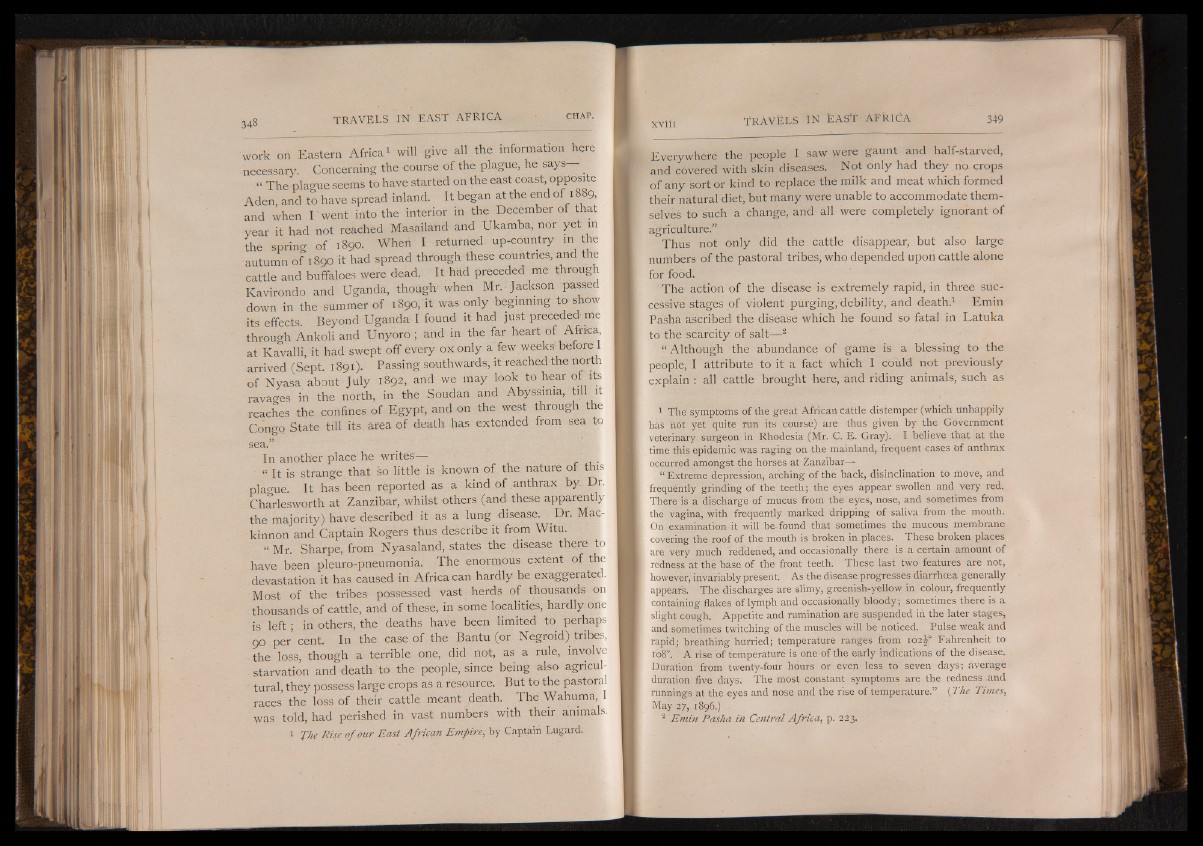
work on Eastern Africa1 will give all the information here
necessary. Concerning the course of the plague, he says
“ The plague seems to have started on the east coast, °PPoslte
Aden, and to have spread inland. It began at the end of 1889
and when I went into the interior in the December of that
year it had not reached Masailand and Ukamba, nor yet in
the sprino- of 1890. When I returned up-country in the
autumn of 1890 it had spread through these countries, and the
cattle and buffaloes were dead. It had preceded me through
Kavirondo and Uganda, though'when Mr. Jackson passed
down in the summer of 1890, it was only beginning to show
its effects Beyond Uganda I found it had just preceded rne
through Ankoli and Unyoro ; and in the far heart of Africa
at Ravalli, it had swept off every ox only a few weeks1 before I
arrived (Sept. 1891). Passing southwards, it reached the north
of Nyasa about July 1892, and we may look to hear of its
ravages in the north, in the Soudan and Abyssinia, till it
reaches the confines of Egypt, and on the west through the
Congo State till its area of death has extended from sea to
sea.”
In another place he writes— .
“ It is strange that so little is known of the nature of this
plague. It has been reported as a kind of anthrax by Dr.
Charlesworth at Zanzibar, whilst others (and these apparently
the majority) have described it as a lung disease. Dr. Mac-
kinnon and Captain Rogers thus describe it from Witu.
“ Mr. Sharpe, from Nyasaland, states the disease there to
have been pleuro-pneumonia. The enormous extent of tte
devastation it has caused in Africa can hardly be exaggerated.
Most of the tribes possessed vast herds of thousands on
thousands of cattle, and of these, in some localities, hardly one
is le ft ; in others, the deaths have been limited to perhaps
90 per’ cent. In the case of the Bantu (or Negroid) tribes,
the loss, though a terrible one, did not, as a rule, involfe
- starvation and death to the people, since being also agricultural,
they possess large crops as a resource. But to the pastoral
races the loss of their cattle meant death. The Wahuma, I
was told, had perished in vast numbers with their animals.
1 7'he Rise o f our East African Empire, by Captain Lugard,
Everywhere the people I saw were gaunt and half-starved,
and covered with skin diseases. Not only had they na crops
of any sort or kind to replace the milk and meat which formed
their natural diet, but many were unable to accommodate themselves
to such à change, and all were completely ignorant of
agriculture.”
Thus not only did the cattle disappear, but also large
numbers of the pastoral tribes, who depended upon cattle alone
for food.
The action of the disease is extremely rapid, in three successive
stages of violent purging, debility, and death.1 Emin
Pasha ascribed the disease which he found so fatal in Làtuka
to the scarcity of salt— ^
“ Although the abundance of game is a blessing to the
people, I attribute to it a fact which I could not previously
explain : all cattle brought here, and riding animals, such as
1 The symptoms of the great African cattle distemper (which unhappily
has not yet quite run its course) are thus given by the Government
veterinary surgeon in Rhodesia (Mr. C. E. Gray). I believe that at the
time this epidemic was raging on the mainland, frequent cases Of anthrax
occurred amongst the horses at Zanzibar—
“ Extreme depression, arching of the back, disinclination to move, and
frequently grinding of the teeth; the eyes appear swollen and very red.
There is a discharge of mucus from the eyes, nose, and sometimes from
the vagina, with frequently marked dripping of-saliva from the mouth.
On- examination it will be- found that sometimes the mucous membrane
covering the roof of the mouth is broken in places. These broken places
are. very much reddened, and occasionally there is a certain amount of
redness at the base of the front teeth. These last two features are not,
however, invariably présent. As the disease progresses diarrhoea generally
appears. The discharges are slimy, greenish-yellow in colour, frequently
containing flakes of lymph and occasionally bloody; sometimes there is a
slight cough. Appetite and rumination are suspended in the later stages,
and sometimes twitching of the muscles will be noticed. Pulse weak and
rapid; breathing hurried; temperature ranges from I0 2 |° Fahrenheit to
108V A rise of temperature is one of the early indications of the disease.
Duration from twenty-four hours or even less to seven days; àveragè
duration five days. The most constant symptoms are the redness and
runnings at the eyes and nose and the rise of temperature.” (The Times,
May 27, 1896.)
2 Emin Pasha in Central Africa, p. 223.